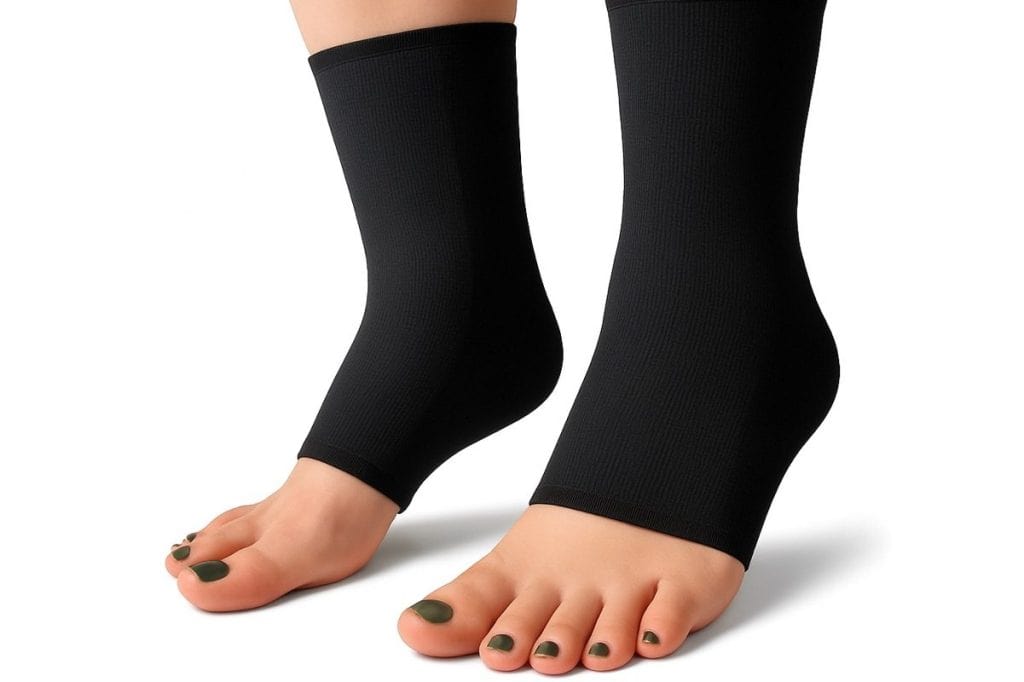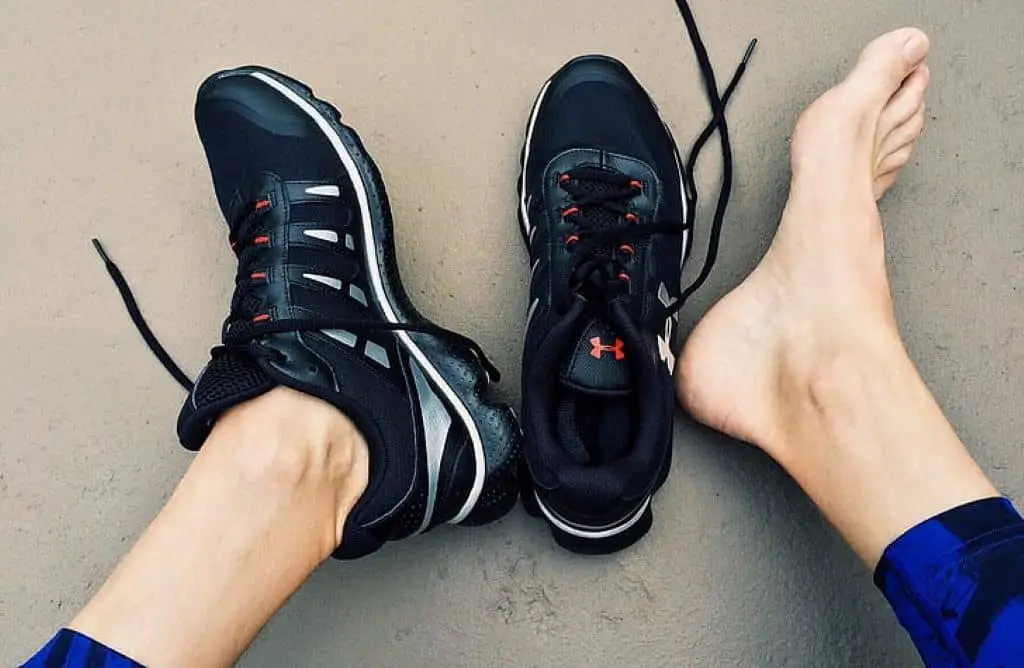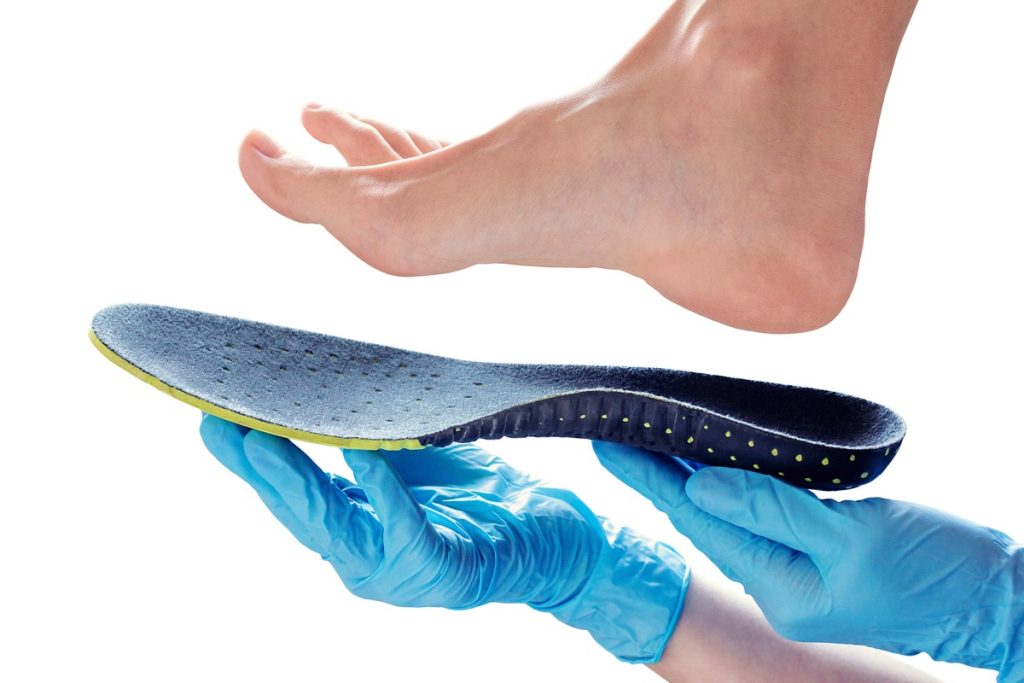Last Updated on May 22, 2025 by Andy Walker
If you suffer from plantar fasciitis, you already know how sharp and persistent the heel pain can be—especially first thing in the morning. While choosing the right shoes for plantar fasciitis is the best defence and the first thing I check wih the runner’s I coach, my second go to is the right socks. They play a crucial role in supporting the plantar fascia ligament and reducing daily discomfort.
In this article, I explain how specialized socks can help,. I’ll review what features to look for, and make some product recommendations you can buy today.
Why Plantar Fasciitis Socks Matter
Socks designed for plantar fasciitis do more than cover your feet—they support your arch, improve circulation, reduce inflammation, and help prevent further tearing of the fascia, especially for runners who tend to run on an injury like that.
Most therapeutic socks use graduated compression, targeted arch support, and moisture-wicking materials to keep your foot stable and reduce swelling. Some styles can even be worn overnight to relieve morning pain.
How to Choose Socks for Plantar Fasciitis
Before buying plantar fasciitis socks, keep the following tips in mind to ensure you’re choosing a sock that actually delivers relief:
- Choose compression, not just cushioning: A little cushion is good, but it’s the firm arch compression that offers real support.
- Look for graduated compression levels: These promote circulation and help reduce inflammation through the arch and ankle.
- Prioritize breathable and moisture-wicking fabric: Dry feet mean fewer blisters and better comfort throughout the day.
- Check for seamless toes: A seamless toe helps avoid irritation, especially during long hours of wear.
- Use ankle-length or crew styles for daily wear, sleeves for sport recovery, and night socks for morning relief.
Top-Rated Plantar Fasciitis Socks
In following table I have listed some of the most popular socks for plantar fasciitis and detailed their support features, comfort, and therapeutic value.
Name | Price Range (USD) | Key Features | How They Help |
|---|---|---|---|
$14–$18 | Firm arch & ankle compression, breathable nylon | Reduces inflammation and pain for all-day wear | |
$8–$20 | Low-profile design, compression support, anti-slip cuff | Great for pairing with any shoe, ideal for mild to moderate pain | |
$14–$30 | Open-toe design, breathable blend, arch support band | Improves circulation and reduces heel strain | |
$15–$30 | Reinforced heel, high arch support, snug fit | Ideal for runners or active users who need extra stability | |
$10–$15 | Thin, lightweight, anti-fatigue compression zones | Discreet under any shoe; provides daylong relief |
When to Wear These Socks
To get the most benefit, wear your plantar fasciitis socks during daily activities or work, especially if you tend to stand for long hours. Also wear them during exercise or walking to reduce inflammation afterward. And at bedtime, wear overnight recovery styles to help reduce morning heel pain. Using socks like these consistently may not cure plantar fasciitis alone, but they can significantly reduce daily discomfort and prevent the pain from getting worse.
Frequently Asked Questions About Sock Fit for Plantar Fasciitis
Here are the most common questions and answers about plantar fasciitis socks:
Plantar fasciitis socks often use graduated compression, which means fit is crucial. Always refer to the sizing chart provided by the brand—most base sizing on shoe size or ankle circumference. If you’re between sizes, opt for the smaller size to ensure adequate compression, unless the brand advises otherwise.
They should feel snug but not painful. The compression should support the arch, heel, and ankle without cutting off circulation. If your toes tingle or your foot turns cold, the sock is too tight and may be restricting blood flow. Mild to moderate compression (15–25 mmHg) is generally ideal for plantar fasciitis.
Yes, most plantar fasciitis socks are designed for daily wear, especially during activities like walking, standing, or working. Just make sure the socks remain comfortable and don’t cause irritation or swelling. Some users find relief by wearing them during the day and switching to a night splint or looser recovery sock while sleeping.
Like most compression gear, plantar fasciitis socks can lose elasticity with heavy use or washing in hot water. To extend the lifespan, wash them in cold water and air dry. Replace them every 3 to 6 months if used regularly to maintain therapeutic compression.
If you’re using compression sleeves (without toes), you can wear them under normal socks for added comfort. Full socks with toes should be worn on their own to allow proper compression. Layering full compression socks with others can reduce effectiveness and cause overheating.
Yes, most plantar fasciitis socks are thin enough to fit comfortably inside athletic or work shoes. Some styles are designed specifically for discreet wear under dress socks or inside tighter footwear. Just make sure they don’t bunch up or create pressure points.
Day socks are thinner and built for mobility, often with moisture-wicking fabric for activity. Night socks or sleeves may use firmer compression or come with a design that gently stretches the plantar fascia while you sleep to prevent morning pain.
You may notice a reduction in heel pain, especially after long periods of standing or after waking up. Many users report feeling less swelling and foot fatigue by the end of the day. However, results can vary, and socks should be used as part of a broader treatment plan that may include stretching, orthotics, and proper footwear.
No, socks help manage symptoms, but they don’t cure the underlying issue. They should be used in conjunction with stretching, icing, massage, proper footwear, and possibly physical therapy. Still, for many, socks are a low-cost way to get relief and prevent worsening symptoms.
Not usually. Most over-the-counter plantar fasciitis socks are safe to try without a prescription. However, if you have circulatory issues, diabetes, or neuropathy, consult your doctor before using compression gear to ensure it’s safe for your condition


